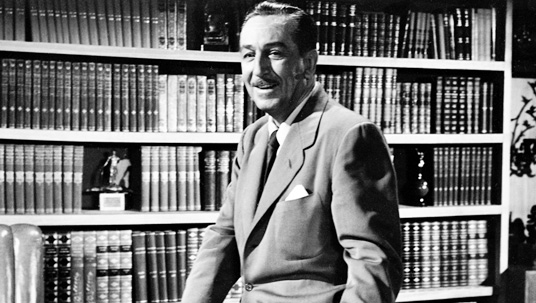Disney, Walter Elias Founder of the Disney empire, Walt Disney was born on December 5, 1901, in Chicago, Illinois, son of Elias and Flora Call Disney. Elias decided a few years later to move his family to a farm at Marceline, Missouri, and it was here that the young Walt grew up and got his first love for animals and the rural life which would be so evident in his films. The family moved to Kansas City in 1911, and Walt delivered newspapers for his father, who had purchased a newspaper distribution business. Walt attended Benton School, and occasionally surprised his teachers with his talent for drawing and acting. When the family moved back to Chicago, Walt attended one year of McKinley High School. The end of World War I saw Walt serving briefly in France as an ambulance driver, but then he returned to Kansas City and attempted to put his art talents to use. After a stint with the Kansas City Film Ad Company, he started his own company, Laugh-O-gram Films, and, with some of his talented friends, made his first animated cartoons. When that business failed, Walt moved to California, and there, with his brother Roy, he started the Disney company in 1923. The company first made a series of Alice Comedies, then a year’s worth of Oswald the Lucky Rabbit cartoons, but in 1928, Walt made history by creating, with the help of his trusted colleague, Ub Iwerks, the character of Mickey Mouse. The Mickey Mouse cartoons were immediately popular and ensured the success of the company. A series of Silly Symphony cartoons was added, and soon the Disney artists began work on their first animated feature film, Snow White and the Seven Dwarfs. That 1937 film was a huge success, becoming the highest grossing film of all time, until it was surpassed by Gone With the Wind. Walt had never been able to make much money with the short cartoons, but the feature films were another story. With the profits from Snow White, he was able to build a new studio in Burbank. Other animated features followed, until World War II caused the Disney Studio to retrench. Much of the company’s effort went into making training and propaganda films for the military. The end of the war brought peace, but prosperity took a while to arrive at Disney’s doors. He bided his time with a group of package films, feature length, but containing a series of two or more short films loosely tied together. Cinderella and the move into live-action films with Treasure Island in 1950 marked a return to financial success. A series of popular True-Life Adventure nature films and a move onto television with a regular weekly program gained the Disney Studio added recognition, but it was the building of Disneyland, the first real theme park, in 1955 that finally made the Disney company financially secure. The added cash flow from the park, along with infusions of cash from merchandise licensing, enabled Walt Disney to attempt new projects. Just before his death on December 15, 1966, Walt was busy planning his Experimental Prototype Community of Tomorrow (EPCOT), which he felt would help solve some of the country’s urban problems. Walt Disney married Lillian Bounds in 1925, and they had two daughters, Diane and Sharon. Disney was a genius in knowing what the public wanted in the way of family entertainment, and he was willing to take chances to create that entertainment. He was an innovator; he was not a follower. When he heard of a new process or concept that interested him, he embraced it totally, often to the dismay of his financial advisers, but time and time again, Walt was proved right. He had his finger on the pulse of America, and a look at his “firsts” helps to show how successful he had been—the first synchronized sound cartoon, the first use of the storyboard, the first full-color cartoon, the first animated feature film, the first stereophonic theater installations with Fantasound, the first popular nature series, the first major movie producer to go onto television, the first CinemaScope cartoon, the first 3-D cartoon, the first use of the Xerox process to facilitate the animation process, the first stereophonic television broadcast, the first theme park. With each of these, Walt took a chance, and with each he proved that he knew what he was doing. All of these elements became standard in the entertainment industry. Walt Disney left a lasting legacy, one which The Walt Disney Company continues to expand upon today.


